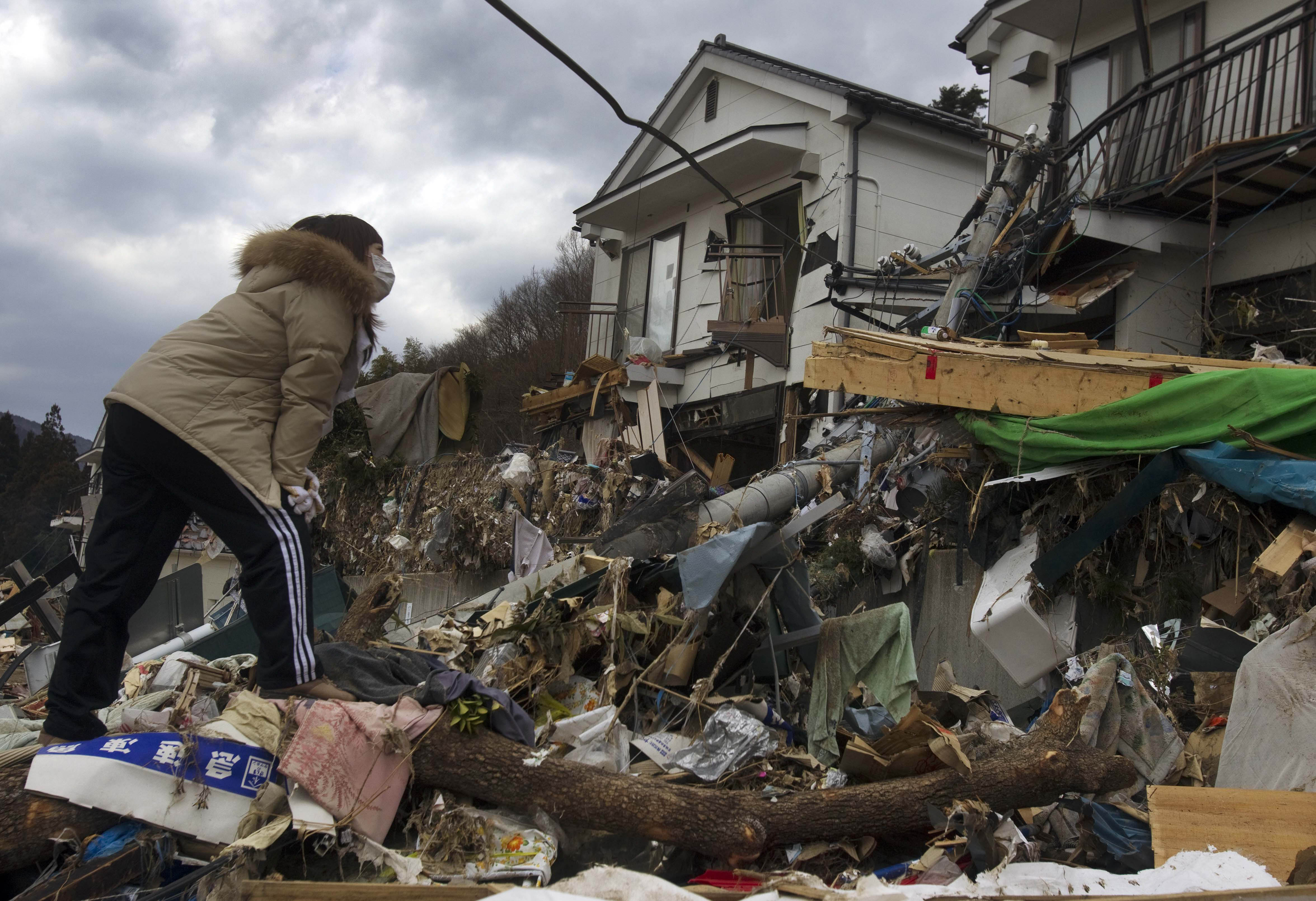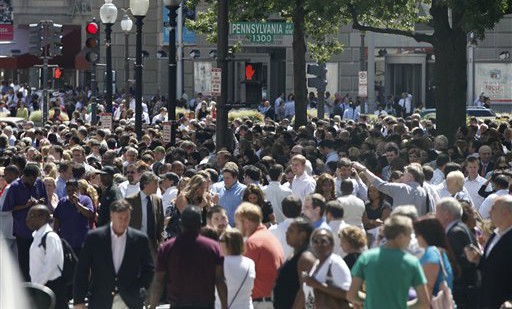

Tayo Kitamura, 40, stands on the rubble of the home of her mother, Kuniko Kitamura, 69, as Japanese fireman discover her mother's body in Onagawa, northeastern Japan Saturday, March 19, 2011. (AP Photo/David Guttenfelder)
The food was taken from farms as far as 65 miles (100 kilometers) from the stricken plants, suggesting a wide area of nuclear contamination.
While the radiation levels exceeded the limits allowed by the government, Chief Cabinet Secretary Yukio Edano insisted the products “pose no immediate health risk.”
Firefighters also pumped tons of water directly from the ocean into one of the most troubled areas of the Fukushima Dai-ichi nuclear complex — the cooling pool for used fuel rods at the plant’s Unit 3. The rods are at risk of burning up and sending radioactive material into the environment.
The news of contaminated food came as Japan continued to grapple with the overwhelming consequences of the cascade of disasters unleashed by a 9.0-magnitude earthquake on March 11. The quake spawned a tsunami that ravaged Japan’s northeastern coast, killing more than 7,300 people and knocking out backup cooling systems at the nuclear plant, which has been leaking radiation.
Nearly 11,000 people are still missing.
The tainted milk was found 20 miles (30 kilometers) from the plant, a local official said. The spinach was collected from six farms between 60 miles (100 kilometers) and 75 miles (120 kilometers) to the south of the reactors.
Those areas are rich farm country known for melons, rice and peaches, so the contamination could affect food supplies for large parts of Japan.
More testing was being done on other foods, Edano said in Tokyo, and if tests show further contamination then food shipments from the area would be halted.
Click here for photos of the earthquake and tsunami in Japan
Officials said it was too early to know if the nuclear crisis caused the contamination, but Edano said air sampling done near the dairy showed higher radiation levels.
Iodine levels in the spinach exceeded safety limits by three to seven times, a food safety official said. Tests on the milk done Wednesday detected small amounts of iodine 131 and cesium 137, the latter being a longer lasting element and can cause more types of cancer. But only iodine was detected Thursday and Friday, a Health Ministry official said.
Officials from Edano on down tried to calm public jitters, saying the amounts detected were so small that people would have to consume unimaginable amounts to endanger their health.
Edano said someone drinking the tainted milk for one year would consume as much radiation as in a CT scan; for the spinach, it would be one-fifth of a CT scan. A CT scan is a compressed series of X-rays used for medical tests.
“Can you imagine eating one kilogram of spinach every day for one year?” State Secretary of Health Minister Yoko Komiyama said. One kilogram is a little over two pounds.
Meanwhile, just outside the bustling disaster response center in the city of Fukushima, 40 miles (60 kilometers) northwest of the plant, government nuclear specialist Kazuya Konno was able to take only a three-minute break for his first meeting since the quake with his wife, Junko, and their children.
“It’s very nerve-racking. We really don’t know what is going to become of our city,” said Junko Konno, 35. “Like most other people, we have been staying indoors unless we have to go out.”
She brought her husband a small backpack with a change of clothes and snacks. The girls — aged 4 and 6 and wearing pink surgical masks decorated with Mickey Mouse — gave their father hugs.
Low levels of radiation have been detected well beyond Tokyo, which is 140 miles (220 kilometers) south of the plant, but hazardous levels have been limited to the plant itself.
Nuclear reactors at the Fukushima plant began overheating and leaking radiation into the atmosphere in the days after the March 11 quake and the subsequent tsunami overwhelmed its cooling systems. The government admitted it was slow to respond to the nuclear troubles, which added another crisis on top of natural disasters, which officials believe killed more than 10,000 people and displaced more than 400,000 others.
There were signs of progress in bringing the overheating reactors and fuel storage pools under control.
A fire truck with a high-pressure cannon was parked outside the plant’s Unit 3, about 300 meters (yards) from the Pacific coast, and began shooting a stream of water nonstop into the pool for seven straight hours, said Kenji Kawasaki, a spokesman for the nuclear safety agency.
A separate pumping vehicle will keep the fire truck’s water tank refilled. Because of high radiation levels, firefighters will only go to the truck every three hours when it needs to be refueled. They expect to pump about 1,400 tons of water, nearly the capacity of the pool.
Edano said conditions at the reactors in units 1, 2 and 3 — all of which have been rocked by explosions in the past eight days — had “stabilized.”
Holes were punched in the roofs of units 5 and 6 to vent buildups of hydrogen gas, and the temperature in Unit 5’s fuel storage pool dropped after new water was pumped in, Tokyo Electric Power Co. said.
“We more or less do not expect to see anything worse than what we are seeing now,” said Hidehiko Nishiyama of the Nuclear and Industrial Safety Agency.
Although a replacement power line reached the complex Friday, workers had to methodically work through badly damaged and deeply complex electrical systems to make the final linkups without setting off a spark and potentially an explosion. Company officials hoped to be able to switch on the all the reactors’ power on Sunday.
Even once the power is reconnected, it is not clear if the cooling systems will still work.
The storage pools need a constant source of cooling water. When removed from reactors, uranium rods are still very hot and must be cooled for months, possibly longer, to prevent them from heating up again and emitting radioactivity.
More workers were thrown into the effort — bringing the total at the complex to 500 — and the safety threshold for radiation exposure for them was raised two-and-a-half times so that they could keep working.
Officials insisted that would cause no health damage.
Nishiyama also said backup power systems at the plant had been improperly protected, leaving them vulnerable to the tsunami.
The failure of Fukushima’s backup power systems, which were supposed to keep cooling systems going in the aftermath of the massive 9.0-magnitude earthquake, let uranium fuel overheat and were a “main cause” of the crisis, Nishiyama said.
“I cannot say whether it was a human error, but we should examine the case closely,” he told reporters.
A spokesman for Tokyo Electric Power Co., which owns and runs the plants, said that while the generators themselves were not directly exposed to the waves, some electrical support equipment was outside. The complex was protected against tsunamis of up to 5 meters (16 feet), he said. Media reports say the tsunami was at least 6 meters (20 feet) high when it struck Fukushima.
Spokesman Motoyasu Tamaki also acknowledged that the complex was old, and might not have been as well-equipped as newer facilities.
People evacuated from around the plant, along with some emergency workers, have tested positive for radiation exposure. Three firefighters needed to be decontaminated with showers, while among the 18 plant workers who tested positive, one absorbed about one-tenth tenth of the amount that might induce radiation poisoning.
As Japan crossed the one-week mark since the cascade of disasters began, the government conceded Friday it was slow to respond and welcomed ever-growing help from the U.S. in hopes of preventing a complete meltdown.
The United States has loaned military firefighting trucks to the Japanese, and has conducted overflights of the reactor site, strapping sophisticated pods onto aircraft to measure radiation aloft. Two tests conducted Thursday gave readings that U.S. Deputy Energy Secretary Daniel B. Poneman said reinforced the U.S. recommendation that people stay 50 miles (80 kilometers) away from the Fukushima plant. Japan has ordered only a 12-mile (20-kilometer) evacuation zone around the plant.
The government on Friday raised the accident classification for the nuclear crisis, putting it on a par with the Three Mile Island accident in Pennsylvania in 1979, and signifying that its consequences went beyond the local area.
This crisis has led to power shortages and factory closures, hurt global manufacturing and triggered a plunge in Japanese stock prices.
Police said more than 452,000 people made homeless by the quake and tsunami were staying in schools and other shelters, as supplies of fuel, medicine and other necessities ran short.
On Saturday evening, Japan was rattled by 6.1-magnitude aftershock, with an epicenter just south of the troubled nuclear plants. The temblor, centered 150 kilometers (90 miles) northeast of Tokyo, caused buildings in the capital to shake.
Eric Talmadge, Associated Press
Shino Yuasa, Associated Press
Yuasa reported from Tokyo, as did Associated Press writers Mari Yamaguchi, Elaine Kurtenbach, Tim Sullivan, and Jeff Donn.
Copyright 2011 The Associated Press.




